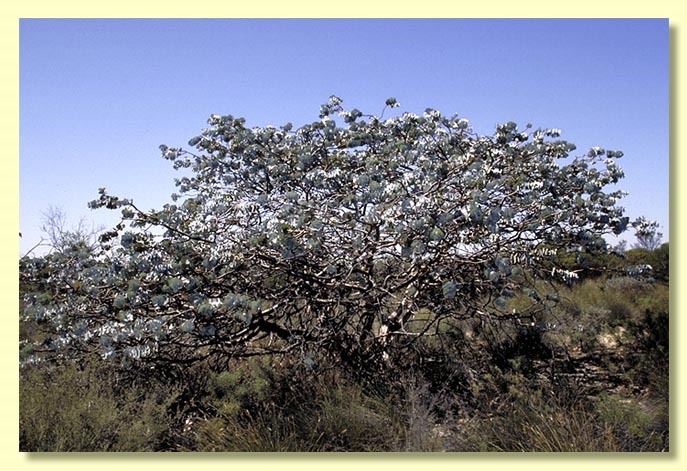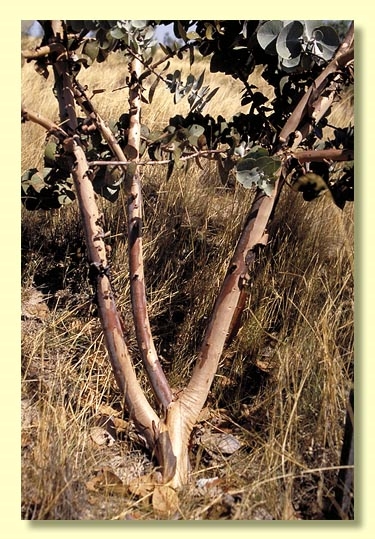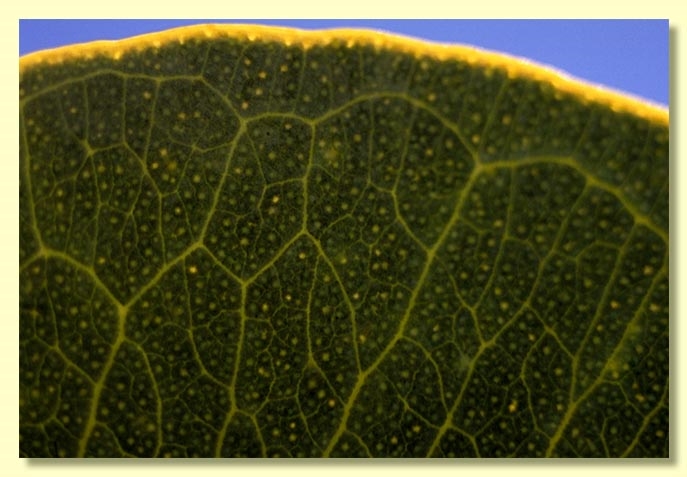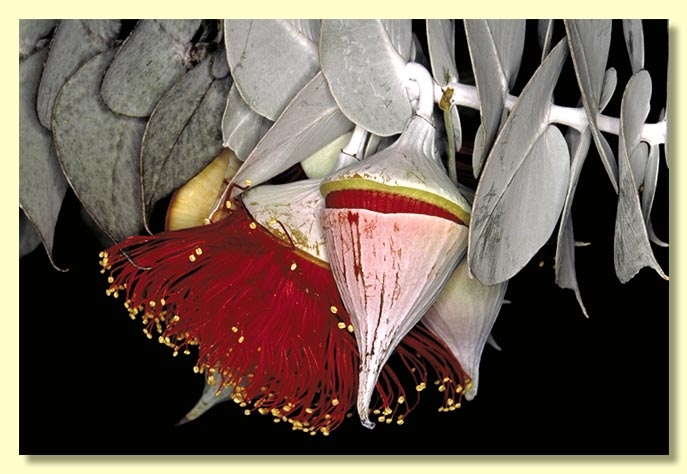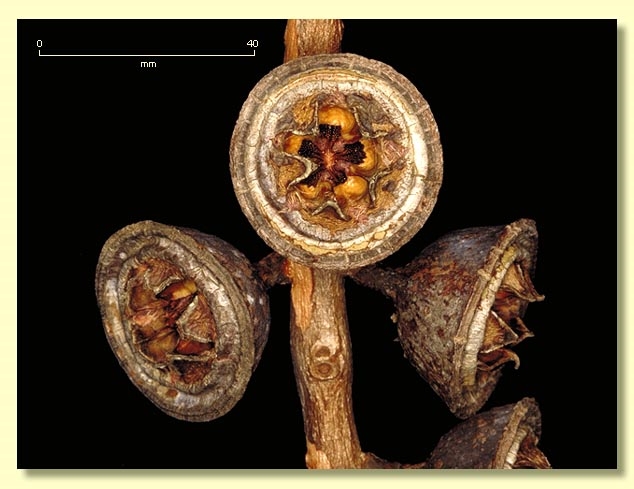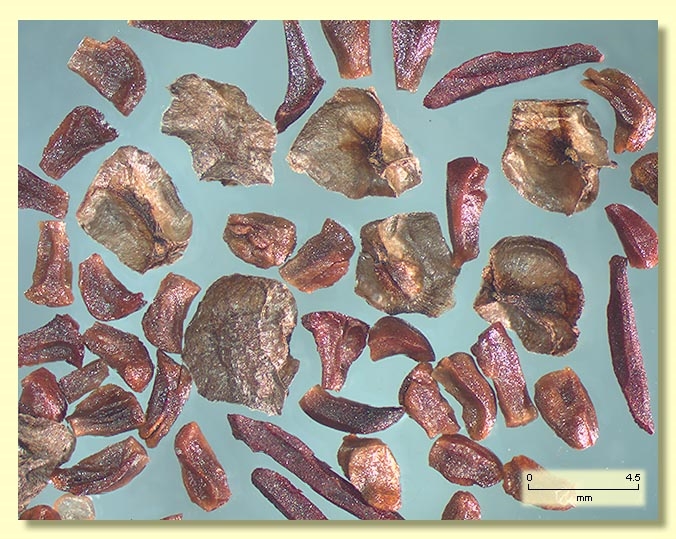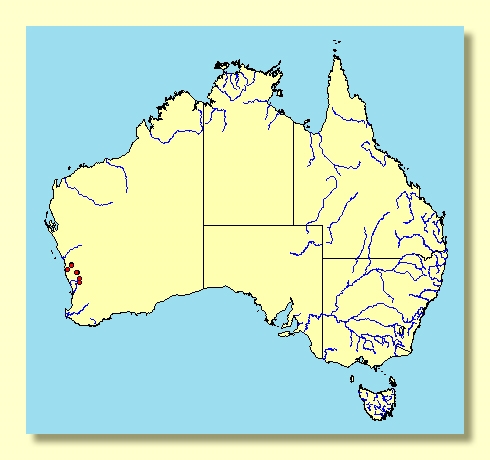Euclid - Online edition
Eucalyptus rhodantha
Eucalyptus | Symphyomyrtus | Bisectae | Destitutae | Curviptera | Xylocarpae
T: near Gunyidi, Victoria Plains, W.A. Dec. 1934, H.Steedman s.n.; holo: NSW349182.
Eucalyptus rhodantha var. petiolaris Blakely & H.Steedman, Australian Naturalist 10: 261 (1941). T: Moora district, Western Australia, Apr. 1939, H.Steedman s.n.; holo: NSW53515.
Bark smooth throughout, grey, grey-brown and pinkish grey.
Branchlets glaucous; lacking oil glands in the pith.
Juvenile growth (coppice or field seedlings to 50 cm): stems rounded in cross-section.
Crown entirely of juvenile leaves, opposite, sessile (rarely with a short petiole), blade cordate, 4.5–9(13.5) cm long, 3–7.5 cm wide, amplexicaul (rarely with the base rounded), margin entire, apex pointed, rarely emarginate or rounded, thick, concolorous, dull, glaucous or weathering to grey-green, side-veins greater than 45° to midrib, reticulation dense, intramarginal vein remote from margin, oil glands few, intersectional.
Inflorescence axillary unbranched, pendulous, peduncles 1–2(3.3) cm long, bud solitary, normally stoutly pedicellate, rarely sessile, pedicels (0)0.8–2 cm long. Mature buds ovate (2.8–5.3 cm long, 2.3–3.7 cm wide), glaucous, often finely ribbed, scar present, operculum beaked (2–3.2 cm long), stamens all inflexed, anthers cuboid, versatile, dorsifixed, dehiscing by longitudinal slits, style long and straight, stigma more or less tapered, locules 4 or 5, the placentae each with 10 vertical rows of ovules. Flowers red.
Fruit rigidly down-turned, pedicellate (pedicels 0.5–1.8 cm long), hemispherical to obconical, 1.6–2.8 cm long, 3.3–4.5 cm wide, disc raised, concave to oblique, valves 4 or 5, exserted.
Seeds grey-brown, 4.5–6.5 mm long, obliquely pyramidal with prominent ridges and an encircling marginal flange to ca 2mm wide, dorsal surface shallowly reticulate, hilum terminal.
Cultivated seedlings (measured at node 10): cotyledons Y-shaped (bisected); stems rounded in cross-section; leaves sessile, opposite, amplexicaul, orbicular to cordate for many nodes, 3–6 cm long, 3–5.5 cm wide, margins entire or subcrenulate, glaucous
Flowering has been recorded in February, May, July, August and September.
E. rhodantha is a popular ornamental although the seed supply is very restricted due to its rarity.
A straggly mallee, endemic to Western Australia, endangered and very restricted in distribution north of Perth, from Watheroo to Three Springs, on gravelly sandy soil. The stems are smooth and the mature crown consists of sessile heart-shaped glaucous juvenile leaves which contrast with the spectacular red flowers.
Eucalyptus rhodantha belongs in Eucalyptus subgenus Symphyomyrtus section Bisectae subsection Destitutae because buds have two opercula, cotyledons are Y-shaped and branchlets lack oil glands in the pith. Within this subsection E. rhodantha is in series Curviptera, one of about 30 closely related species and subspecies which are further characterised by having large buds in umbels of one, three or seven, staminal filaments erect or oblique (rarely inflexed) in bud, and large fruit usually with an ascending disc and exserted valves. Several of these species are noted for their large-leaved crowns made up of juvenile leaves.
E. rhodantha is distinguished from closely related single-budded species E. macrocarpa and E. impensa, by the combination of sessile glaucous leaves (though a few shortly petiolate leaves may be present) and pedicellate buds on down-turned peduncles to 3.3 cm long. E. macrocarpa has similar leaves to E. rhodantha but has buds without pedicels and erect stout peduncles to 0.1–1 cm long. E. impensa has petiolate leaves that are non-glaucous and stoutly pedicellate buds on erect peduncles to 2 cm long. Flowers of E. rhodantha and E. macrocarpa are red or rarely creamy white, those of E. impensa are pink.
Plants of E. rhodantha that have some petiolate and sub-opposite lanceolate leaves to 13 cm long are known and have been described as var. petiolaris. This represents a tendency towards a more adult crown compared with the more usual juvenile crown seen in most reproductively mature plants. We include E. rhodantha var. petiolaris in E. rhodantha.
Eucalyptus rhodantha var. petiolaris is listed as "Endangered", and E. rhodantha var. rhodantha is listed as "Vulnerable" under the Australian Government Environment Protection and Biodiversity Conservation Act 1999 (EPBC Act). Further information may be found at this web address:
http://www.environment.gov.au/cgi-bin/sprat/public/sprat.pl

